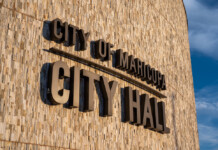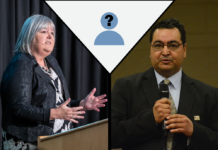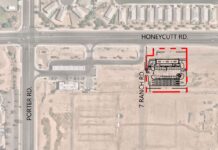
In a perfect world, the Maricopa Public Library would be around 46,000 square feet. The industry standard is one square foot of library space per resident.
The library is 8,000 square feet.
It averages more than 6,000 visitors per week. It has a membership of nearly 40,000 registered users. It has a collection of more than 42,000 items.
The staff of eight (and a half) workers handles more traffic per week than the Copper Sky Multigenerational Complex.
Dorrine Tevault, who chairs the city’s Parks, Recreation and Libraries Commission, says the library “is an outstanding, overworked, hard-working, very successful” element of Maricopa.
“Expanding it is not an option. Building another one might be an option, but what they’re doing with the limited resources that they have and the limited space that they have is top-notch,” she says.
Expansion is out, Library Manager Erik Surber says, because the city does not own the property surrounding the building.
And the building is only 5 years old. Its construction was a major milestone for the city, so conversations about building a new library are limited.
“Building a new library has been talked about several times,” Tevault says, “but it comes down to the finances of getting it done. That’s something we find everywhere, not only in Maricopa.”
For 33 years, the library did not even have its own building. It was run by volunteers from a variety of locations, like a school, the post office and even the jail.
Its first home on Maricopa-Casa Grande Highway came from the 1988 purchase of a Williams Air Force Base barracks building. The library continued to be operated by volunteers of the Maricopa Cultural Activity, which became the Friends of the Maricopa Public Library. After Maricopa incorporated in 2003, the library came under the auspices of city hall in 2004 and staff was hired.
When the building on Smith-Enke was built, the former library became the Maricopa Veterans Center. But the Friends continue their work.
“We rely on our volunteers a lot,” Surber says.
While the new building may be deemed small for the number of its patrons, Surber says the library should have even more traffic in a city the size of Maricopa.
“This is a city of 40,000-some people,” Surber says. “[The library] really isn’t that busy when you compare it the number of people we have in the city. Our visitorship per capita isn’t spectacular. It’s rather ordinary.”
For a facility its size, however, it is extremely busy. Having a visitorship more reflective of the Maricopa population would force the issue of lack of space at the library, not to mention staffing. As it is, an average of 1,000 visitors a day for such a small staff keeps it livelier than many of its contemporaries.
“That means our staff is the hardest-working staff in the country,” Surber says. “I’m very proud of the hard-working staff. The fact that everybody here works very hard as a team and still has time to come up with new program ideas and implement them.”
“What they do and what they have been doing with the volunteers they have and the workers – everybody from Erik all the way down – they have provided such an outstanding place for kids and adults to continue with their reading and classes,” Tevault says.
In fact, Maricopa Public Library is in the top 20 libraries in the nation in all categories indicating a busy library.
It ranks 20th in attendance at its programs per full-time worker, fifth in circulation per full-time worker, fifth in visitorship per full-time worker and first in hours open.
“We employ a different philosophy of what a library is and should be here,” Surber says. “The library isn’t a place just to get books, although you can get books there. A library isn’t just a place to read or to get onto the Internet. A library is a reflection of the community. It’s where they come together.
“More than anything the library is a physical space. In this day and age when so many people are disconnected from one another, because of the digital advances that we have experienced in the last 20 years or so, the library is more and more important. Our visitorship has gone up. Libraries in general have had visitorship go up because people see it as more of a space.”
He says many, but not all, people have resources available at home, but they turn to the library as a place to bring all that information together.
Programs at the library often emerge from the talent and interests of the staff. If an idea catches on with the public, the library will build on that.
A home-school LEGO program has proven so popular the library is changing it from once a month to twice a month. A scrapbooking class, on the hand, was not well attended, but Surber will give it another chance.
In a building the size of the Maricopa library, programs can conflict. With a Pew poll indicating the two top reasons people frequent a library are for the children’s storytime and for a quiet place to read, the overlap is a “troublesome mix.”
Tevault says she would like the city to expand the space to expand its services. What that would look like is still up in the air.
Surber says he’s heard discussions about opening a branch, which he opposes primarily because of the cost and duplication of services.
The library has 963 programs annually, placing it in the top dozen in the state.
The library’s “juvenile” clientele (age 11 and under) is among the most active. It is continuing to grow its young adult programs. That includes a book discussion group, which turned into a teen advisory council, a gamers guild and a tech week.
“I’m so happy with our young adult programs,” Surber says. “The fact that it’s up and running and expanding is a dream of mine.”
And the 20-somethings, he says, are the group that reads the most.



![Elena Trails releases home renderings An image of one of 56 elevation renderings submitted to Maricopa's planning department for the Elena Trails subdivison. The developer plans to construct 14 different floor plans, with four elevation styles per plan. [City of Maricopa]](https://www.inmaricopa.com/wp-content/uploads/2024/04/city-041724-elena-trails-rendering-218x150.jpg)
![Affordable apartments planned near ‘Restaurant Row’ A blue square highlights the area of the proposed affordable housing development and "Restaurant Row" sitting south of city hall and the Maricopa Police Department. Preliminary architectural drawings were not yet available. [City of Maricopa]](https://www.inmaricopa.com/wp-content/uploads/2024/04/041724-affordable-housing-project-restaurant-row-218x150.jpg)

![City looks to lower property taxes again City Manager Ben Bitter speaks during a Chamber of Commerce event at Global Water Resources on April 11, 2024. Bitter discussed the current state of economic development in Maricopa, as well as hinting at lowering property tax rates again. [Monica D. Spencer]](https://www.inmaricopa.com/wp-content/uploads/2024/04/spencer-041124-ben-bitter-chamber-property-taxes-web-218x150.jpg)






![Alleged car thief released without charges Phoenix police stop a stolen vehicle on April 20, 2024. [Facebook]](https://www.inmaricopa.com/wp-content/uploads/2024/04/IMG_5040-218x150.jpg)



